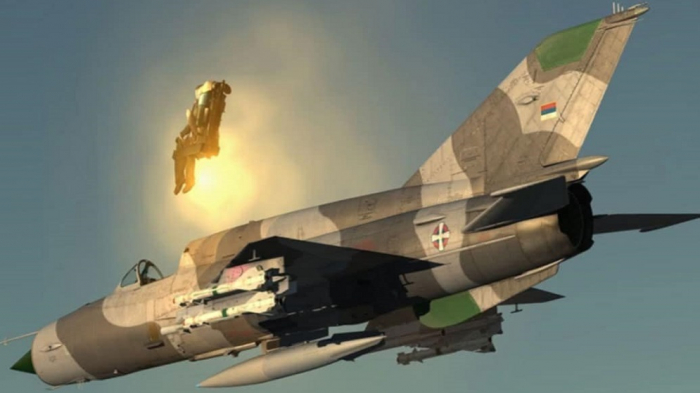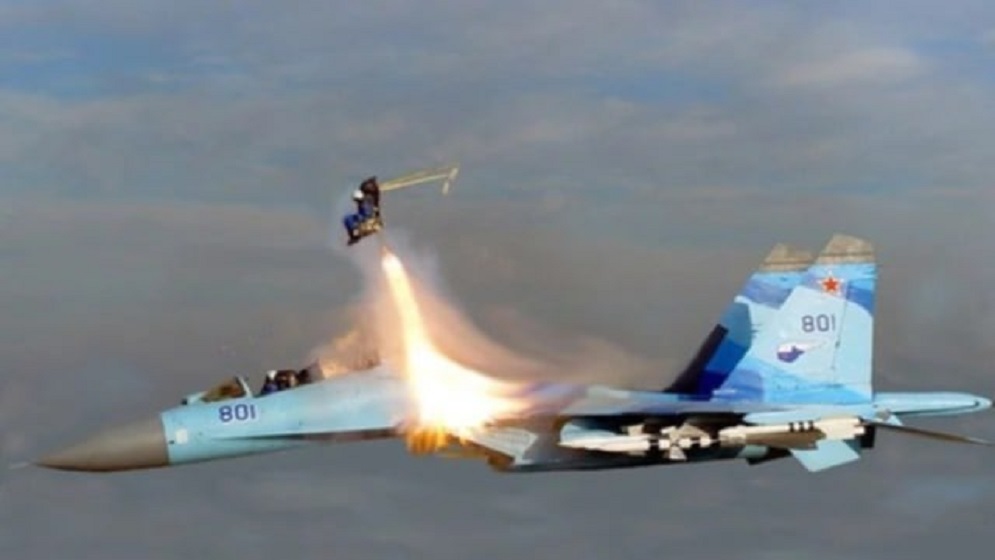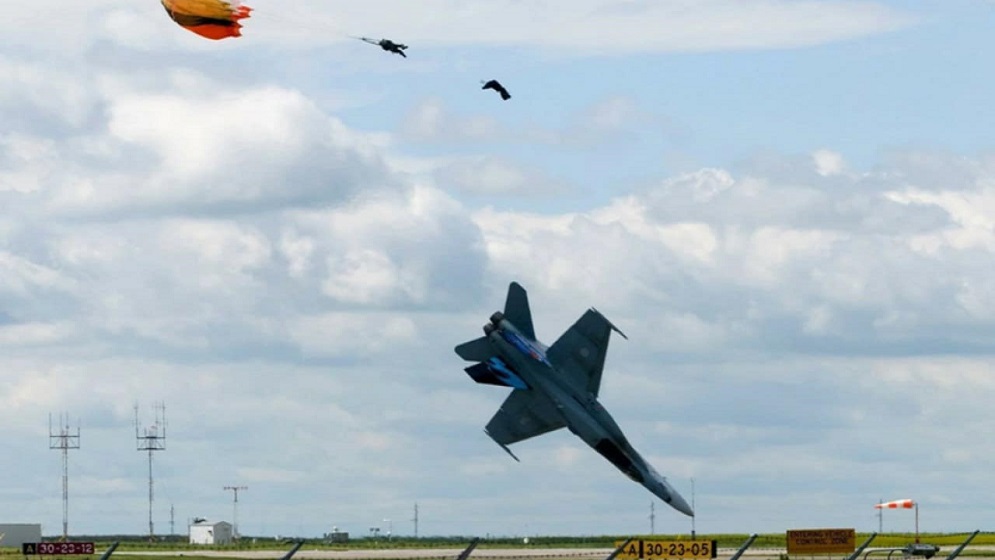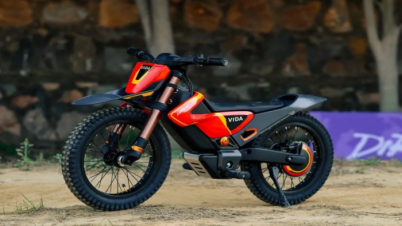Ejection Seats: The Last Resort in Aerial Emergencies
Anonno Aziz Nibir
লাইফ টিভি 24
প্রকাশিত: ১৬:১৬ ২৩ জুলাই ২০২৫

When an aircraft, typically a military jet, fails mid-air, whether due to mechanical malfunction, hostile engagement, or structural compromise, pilots have mere seconds to choose between survival and catastrophe. At that critical moment, one system stands between life and death: the aircraft ejection seat.
Ejection is not taken lightly. Pilots are trained extensively to troubleshoot and regain control of their aircraft in emergencies. But when a situation becomes irrecoverable, the pilot must make a rapid and irreversible decision: to leave the aircraft. While it might appear instantaneous in movies, in reality, it's a complex, precision-engineered sequence involving high-stakes decision-making, human judgment, training, reflex, and precise timing.
“It’s the hardest choice you’ll ever make in a fraction of a second,” the lesson goes. “You’re trained for it, but nothing truly prepares you for the moment your instincts and training collide.”
Aircraft ejection systems are a marvel of aeronautical engineering, designed to thrust a pilot clear of a failing aircraft and ensure safe descent via parachute. Modern ejection seats are powered by explosive cartridges or rocket motors, capable of propelling the pilot upward at speeds exceeding 1,000 km/h. Here is how it works:
1. Emergency Recognition
The pilot detects a critical failure or threat, such as engine failure, fire, or loss of flight control, and determines that ejection is the only viable option.
2. Ejection Initiation
The pilot pulls a marked handle or lever, typically located between the legs or above the head. This instantly locks the pilot into the seat, arms the ejection system, and activates the canopy jettison or shattering mechanism to clear a path.

3. Canopy Removal and Launch
The aircraft canopy is either blown off or shattered by small explosive charges. Simultaneously, the ejection seat, powered by a rocket motor or explosive cartridge, propels the pilot upward, away from the aircraft at extreme speed. The rapid vertical acceleration exposes the pilot to extreme G-forces, sometimes over 20 Gs, which can lead to temporary blackouts or physical injury.
4. Separation and Parachute Deployment
After clearing the aircraft and reaching a safe altitude, the ejection seat automatically separates from the pilot. A main parachute deploys, slowing the descent and stabilizing the fall.
5. Safe Landing and Rescue
The pilot lands with the assistance of the parachute. Search and rescue teams are often dispatched immediately, especially in military operations, to locate and extract the downed crew.
Modern ejection seats, such as those manufactured by companies like Martin-Baker (UK) or NPP Zvezda (Russia), are highly sophisticated, equipped with automated functions, GPS tracking, and stabilization parachutes to improve survivability in extreme conditions. Other models are equipped with sensors that calculate altitude, speed, and attitude to determine the precise moment of parachute deployment. In advanced combat aircraft, the entire sequence is automated within milliseconds to compensate for extreme flight conditions.
There are also variations in seat design: Single-seat systems, found in fighter jets like the F-16 or MiG-29, designed for one pilot; Twin-seat systems, found in training jets or bombers, often programmed to eject both crew members simultaneously or in sequence; Zero-zero seats, capable of safe ejection at zero altitude and zero airspeed, ideal for takeoff and landing emergencies.

Despite its life-saving purpose, ejection is not without danger. The forces involved are immense. Pilots experience rapid acceleration, sometimes over 20 times the force of gravity (20 Gs), which can cause serious spinal injuries, dislocations, or even unconsciousness.
Additionally, there are limitations: low altitude or high speed can render the system ineffective or fatal; system failure, though rare, can have catastrophic consequences; the high G-force experienced during ejection can cause spinal compression, fractures, or dislocated joints; environmental hazards, such as mountains, forests, or open water, complicate rescue efforts and pose survival risks even after a successful ejection.
In some cases, especially in combat zones, ejecting pilots have had to evade capture or survive in hostile terrain for hours or even days before rescue.
Ejection seats have become a standard safety feature in virtually all modern combat aircraft. Since their invention during World War II, they have saved the lives of over 15,000 pilots around the world, according to Martin-Baker. In some cases, pilots have ejected at altitudes as low as 100 feet or at speeds approaching Mach 2 and lived to tell the tale.
Though fraught with danger, the ejection system remains a pilot’s last and best hope when all else fails. While we often celebrate the feats of aviation in terms of speed, power, and precision, the quiet assurance of the ejection seat reminds us of a deeper truth: in the sky, as on the ground, life must always come first.
- হলফনামায় সম্পদের যে বিবরণ দিলেন বাবরসহ বিএনপির ৫ প্রার্থী
- নির্বাচনে শঙ্কা তৈরি হয়েছে, পরিস্থিতি হতাশাজনক: আসিফ মাহমুদ
- গৃহকর্মী নিয়োগের আগে যেসব বিষয় যাচাই-বাছাই জরুরি
- মোস্তাফিজকে বাদ দিতে কোনো আলোচনা হয়নি বিসিসিআইতে
- ভোটকেন্দ্রের দিকে তাকিয়ে ভোটাররা: ইসি সানাউল্লাহ
- খালেদা জিয়ার যে নির্দেশ মেনে চলছেন আসিফ
- প্রাথমিক বিদ্যালয়ের শিক্ষকদের জরুরি নির্দেশনা
- এসএসসি, এইচএসসি ও স্নাতকে বৃত্তি বাড়ছে, দ্বিগুণ হচ্ছে টাকা
- প্রাথমিক শিক্ষক নিয়োগ: পরীক্ষার্থীদের জন্য জরুরি নির্দেশনা
- মনোনয়ন বৈধ-অবৈধ, যে কেউ আপিল করতে পারবেন: ইসি সচিব
- সোয়েটার কি ত্বকে র্যাশ তৈরি করছে? কারণ জানুন
- আইপিএলের সম্প্রচার বন্ধের সিদ্ধান্ত বাংলাদেশের
- মাছ-মাংস খান না জেনেলিয়া, মুখে নেন না দুধও
- ফাঁদ থেকে উদ্ধার বাঘের জ্ঞান ফিরেছে, যাচ্ছে আবাসে
- এলপিজির দাম বাড়ল
- বাসচালক থেকে প্রেসিডেন্ট, ভেনেজুয়েলায় যা যা করেছেন মাদুরো
- সেই ভিক্ষুকের মনোনয়ন বাতিল
- যেকোনো বিষয়ে স্নাতক পাসেই চাকরি দিচ্ছে সিটি ব্যাংক
- শীতে খেজুর গুড়ের উপকারিতা
- ‘প্রিন্স’ শাকিবের নায়িকা বিভ্রাট, গুঞ্জন চলছেই
- ভারত থেকে বিশ্বকাপের ম্যাচ সরাতে আইসিসিকে চিঠি বিসিবির
- যেভাবে জিয়াউর রহমানকে সংসদ এলাকায় কবর দেওয়ার সিদ্ধান্ত হয়
- খেতে খেতে ফোন: স্বাস্থ্যের জন্য ৭ মারাত্মক ক্ষতি
- মেসির সামনে নতুন রেকর্ডের হাতছানি
- নতুন খবর দিলেন জয়া
- ই-সিগারেট ও ভেপ নিষিদ্ধ, ধূমপানে বাড়লো জরিমানা
- মোবাইল ফোন আমদানিতে কমল শুল্ক, ছাড় উৎপাদনেও
- হলফনামায় যেসব সম্পদের বিবরণ দিলেন ফয়জুল করীম
- স্বামীর পাশে চিরনিদ্রায় খালেদা জিয়া
- ঘুমের জন্য অন্ধকার কেন প্রয়োজন
- খালেদা জিয়াকে নিয়ে লেখা ১০ বই
- যেভাবে জিয়াউর রহমানকে সংসদ এলাকায় কবর দেওয়ার সিদ্ধান্ত হয়
- লোগো প্রকাশ করল সম্মিলিত ইসলামী ব্যাংক
- ই-সিগারেট ও ভেপ নিষিদ্ধ, ধূমপানে বাড়লো জরিমানা
- হলফনামায় যেসব সম্পদের বিবরণ দিলেন ফয়জুল করীম
- রুমিন ফারহানা-সাইফুল ইসলাম নীরবসহ ৯ নেতা বহিষ্কার
- দরবেশের ভবিষ্যৎ বাণীতেই খালেদা জিয়ার জীবনের দিশা ছিল
- নতুন খবর দিলেন জয়া
- খেতে খেতে ফোন: স্বাস্থ্যের জন্য ৭ মারাত্মক ক্ষতি
- ঘুমের জন্য অন্ধকার কেন প্রয়োজন
- স্বামীর পাশে চিরনিদ্রায় খালেদা জিয়া
- মেসির সামনে নতুন রেকর্ডের হাতছানি
- এলপিজির দাম বাড়ল
- শাকিব, চঞ্চল, অপু ও বাঁধনসহ তারকারা ফেসবুকে কে কি লিখলেন
- প্রাথমিক শিক্ষক নিয়োগ পরীক্ষা স্থগিত
- বিএনপিতে যোগদানের পর কনকচাঁপাকে যে প্রশ্ন করেন খালেদা জিয়া
- নিজ হাতে মাকে কবরে শায়িত করলেন তারেক রহমান
- সেই ভিক্ষুকের মনোনয়ন বাতিল
- খালেদা জিয়ার মৃত্যুতে শোক জানালেন তামিম-শান্তরা
- হাত মেলালেন ভারতের পররাষ্ট্রমন্ত্রী ও পাকিস্তানের স্পিকার





